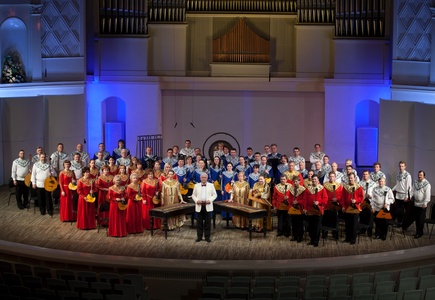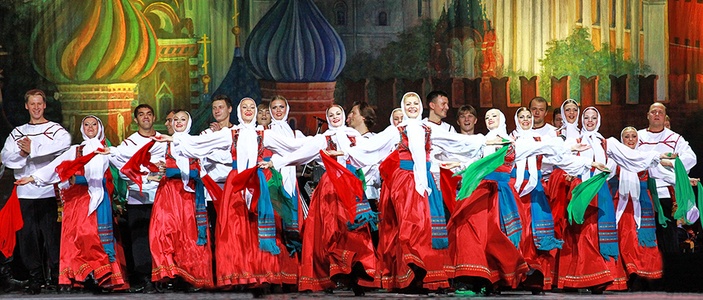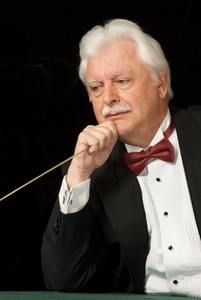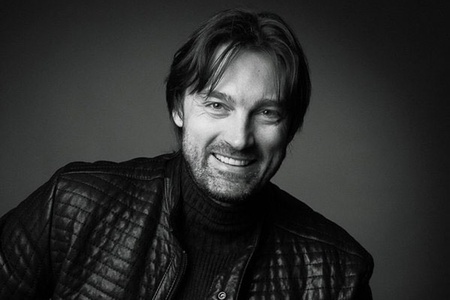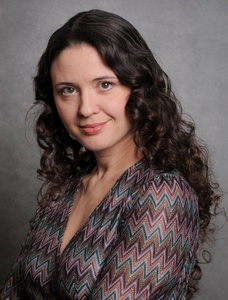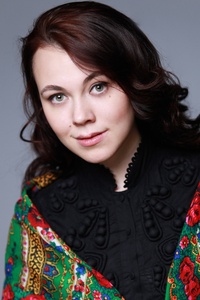N. V. Gogol. "The Night before Christmas"
December 20, 2018
Rachmaninov Concert Hall (Philharmonia-2)
directions to the hallThe Ossipov Balalaika Orchestra
Vladimir Andropov, conductor
Alexander Arsentiev (spoken word artist)
Anna Garnova (spoken word artist)
Darya Rubtsova (vocal)
Alexander Skvarko (tenor)
The Pyatnitsky Russian Folk Choir

Subscription №117:
"What the charm are these fairy tales!"
The Ossipov Balalaika Orchestra
The history of The Ossipov Balalaika Orchestra founded in 1919 by two prominent musicians, balalaika player Boris Troyanovsky and domra player Pyotr Alexeyev, is full of triumphs, quests for perfection and unexpected twists of fate. The Orchestra, which was the first Moscow-based orchestra of folk Instruments, started touring the USSR soon after its first concert, performing in nearly every region of the enormous country, from Sakhalin to the Carpathians, from the White Sea to the Caucasus.
Meanwhile, the changed twice its official name, becoming the All-Russian Radio Committee Folk Instruments Orchestra in 1928, and renamed the State Folk Instruments Orchestra of the USSR in 1936.
Appointing prominent Soviet musician Nikolay Ossipov as its Chief Conductor and Music Director in 1940 marked a new page in the Orchestra’s history. When he passed away, Dmitry Ossipov took over. He changed the team’s performing techniques in a significant way, adding new instruments such as gusli and button accordion, and introducing works for balalaika duos and unison. New pieces were also commissioned from N. Boudashkin, A. Novikov, A. Kholminov, and other composers. Nikolay Ossipov ended up introducing to the audience a completely new orchestra with infinite performing capacities, eager to perform any kind of music, from simple arrangement of folk songs to symphonies.
In June 1941, when World War II started, the Orchestra was disbanded, and almost all the musicians went to fight. In September 1942, however, the Soviet Government decided to reconvene the ensemble. Nikolay Ossipov and manager Boris Romanov brought a lot of musicians back to Moscow. The Orchestra was reestablished and got new official name: the State Russian Folk Orchestra. Numerous concerts were given during the war at different front lines. The last of these “war concerts”, dedicated to the Great Victory, was played in the Kremlin.
In 1946 the Orchestra was named after Nikolay Ossipov. Over the following years, the Ossipov Balalaika Orchestra was headed by Dmitry Ossipov, Viktor Smirnov, Vitaly Gnutov, Viktor Dubrovsky, and Nikolay Kalinin. Prominent conductors who have conducted the OBO include Nikolay Golovanov, Nikolay Anossov, Alexander Gauk, Gennady Rozhdestvensky, Veronika Dudarova, and Vladimir Fedoseyev, to name a few.
In 1969, the OBO received an honorable title of the Academic Orchestra. In June 1996, the Russian Ministry of Culture gave the Orchestra a new official name: the Ossipov National Academic Folk Instruments Orchestra of Russia.
Viktor Dubrovsky, often referred to as “a Russian genius”, opened a new page in the Orchestra’s history. It was under his baton that the musicians’ performance reached a new quality level. OBO began performing arrangements of Russian, European and Soviet classical masterpieces including works of Rossini, Mendelssohn, Glinka, Mussorgsky, Stravinsky, Shostakovich, Sviridov, and Shchedrin.
Performing under Nikolay Kalinin was inspiring in many ways for the Ossipov orchestra and, yet it was the time of hard and meticulous work. Maestro Kalinin identified three pillars of the Orchestra’s evolution: strong professionalism, original and spectacular repertoire, and educational activities.
Vladimir Ponkin became the Orchestra’s Artistic Director and Principal Conductor in 2005. Since 2009, this position has been held by Vladimir Andropov, one of Russia’s most talented and prominent conductors. Under his guidance, the Orchestra keeps preserving and developing the Russian folk music tradition.
Darya Rubtsova
Daria Rubtsova was born in 1993 into a Cossack family. She began studying music in earliest childhood and became a member of the Kazachata (Little Cossacks) children’s performance group at the age of 4. At the age of 15, she became a soloist of the Russkaya Udal ("Russian Daring") State Orchestra of the Adygeya Republic Philharmonic Society (with Anatoly Shipitko as Artistic Director and Chief Conductor). With these ensembles, she has toured villages and towns in Russia, as well as European countries (Poland, Germany, Romania, Serbia, Bulgaria, etc.)
After graduation from Astrakhan State Conservatory (Solo Folk Singing department), Daria became prize-winner of Russian and international competitions including the 7th International Pop Singing Competition (Bulgaria, 2008, 1st Class Diploma), 7th Open International Competition of Pop and Folk Art Diamonds of Russia (Moscow, 2012, Grand Prix), International Vocal Competition Baltiyskaya Feeriya (Baltic Extravaganza) (St Petersburg, 2012, 1st Class Diploma).
Since November 2012, she has been a soloist of the N. P. Osipov State Russian Folk Orchestra. She is actively involved in concert and touring activities as a member of the Young Soloists Ensemble and Balalaika Sextet of the Osipov Orchestra.
The Pyatnitsky Russian Folk Choir
In 1910, under the leadership of M. E. Pyatnitsky, a choir of peasants from Voronezh, Ryazan and Smolensk provinces was organized. The original choir was small: a well-known photograph depicts Mitrofan Efimovich and only fourteen choristers wearing folk costumes. The first concert of the choir, held March 2, 1911 in Moscow turned out to be sensational. The audience of the Small Hall of the Noble Assembly, listened to genuine, deeply touching songs with great admiration. It was also noted by both great Russian musicians S. V. Rakhmaninov and F. I. Shalyapin who appreciated the Russian folk song very well.
It was in the early 1920's that the singers started to receive invitations to various concerts in Moscow. Upon the end of the performance, the artists would travel back to their villages and return to their routine peasant activities. In was in October 1917 that the peasant choir began a new chapter of its life. On September 22, 1918 at a concert of the choir before the Kremlin cadets they met Lenin, who invited Pyatnitsky for a conversation in the Kremlin. Evaluating the dignity and great potential of the new team, Lenin promised Pyatnitsky all the assistance. Participants of the choir moved to permanently reside in Moscow. Their professional activity becomes intense, and with the opening of regular radio broadcasting in November 1924, the choir was recognized, loved, and heard by the entire nation.
In 1927 M. E. Pyatnitsky died. The collective is then named after its founder, and is succeeded by Pyatnitsky’s nephew Pyotr Mikhailovich Kazmin, a person with an outstanding personality, a great connoisseur of Russian folk art.
A Media campaign was launched in 1929 under the motto "We need an old choir singing songs of a kulak village. New songs to the new village. " In 193, a talented composer Vladimir G. Zakharov took over, putting an end to the creativity crisis that the choir was experiencing at the time. He took a different approach to development of the collective. Some author's songs, including glorifying commenced collectivization, electrification, industrialization started to make their way to the choir’s repertoire, such as: "Along the Village", "Petrusha takes us fro a truck ride", "Green Space", etc. People learned the lyrics written by V. G. Zakharov such as: "And who knows", "Awake", and "In the open field" by heart. Those highly renewed songs had made their way to peoples heart eventually becoming people's folk songs.
During the Great Patriotic War, the Choir continued to actively hold concerts, performing before the military brigades. Live broadcasts of their concerts from the studio of the House of Sound Records were popular at the time and were listened to by rank and file commanders, pilots and sailors. Thousands of letters from those would come addressed to Pyatnitsky's Chorus and are still kept to this day. The song "Oh, my fogs, groomsmen", written in 1943 by V. Zakharov in the lyrics of M. Isakovsky, acquired the national popularity becoming the anthem of the partisan movement.
May 9, 1945, along with the winners, the choir took an active part in the festivities dedicated to the Great Victory in Moscow. In the post-war years, the tour-concert activity of the collective is expanding. Since the late 1940s, the choir began to tour around European countries. It was then that the choir becomes truly famous.
In 1936, a significant event occurred in the course of the choirs development. It merged with the professional collective in the Moscow State Philharmonic Society. In 1938 a dance group was formed in the team founded by Tatyana Alekseevna Ustinova. An outstanding choreographer, a student of the Moscow Choreographic School, she gave the choir more than 60 years of her creative life. Tatiana Ustinova studied the folk choreographic language of various regions of Russia and incorporated it into her dance compositions. She is the author of the famous "Voronezh step", when the female dancers float unhurriedly in a dance juts like swans.
In the same year, an orchestra group headed by Vasily Vasilyevich Khvatov appeared in the band. Being a talented musician, he created a unique orchestra, which included bayans, harmonies, horns, balalaikas, domra, gusli, ratchets. The sound of the new instruments added a new perspective to the concerts that would change the general mood of the songs and dances performed before. The choir’s glory have beenmultiplied over and over throughout the years by its leaders and through their work and dedication. Marian Viktorovich Koval, a well-known Soviet composer was in charge of the Choir in 1957 through 1962. In 1959 the collective was awarded the Order of the Red Banner of Labor for great creative achievements.
In 1962 a new era began in the history of the choir. The main national collective of the country was headed by composer Valentin Sergeevich Levashov, who remained in this post for more than twenty years. A sincere and admirable song writer, whose songs "On the outskirts", "How can I not love this land", "Accordion sings at crossroads" constituted so-called the "golden fund" of Soviet music art. A great place in the repertoire of the choir of this period consisted predominantly of the vocal and choreographic suites and compositions representing the culture and ethnographic of various regions of Russia: "Bryansk merrymaking", "Kaluga" and "Blossom, Land of Spring!", "Hello, Volga!", "A Poem about Moscow", latter with a modern vibe. Such compositions demanded a complex polyphony and high performing skills of the singers, dancers, and musicians.
In 1968, having received a high academic title, the folk choir entered the elite of Russian culture and art. The tour activity of the collective was definitely on the rise. All of the Soviet Union as well as countries abroad had at some point heard about the choir. The geography of tours continued to expand, the choir was applauded and admired in more than 40 countries. "Russian artists take our hearts into their own hands," the foreign media wrote with admiration. In 1986, Pyatnitsky Choir was awarded the Order of Peoples’ Friendship.
Starting from 1989, the Pyatnitsky Choir is headed by Alexandra Andreevna Permyakova. For many years she worked in the team, possessing a great talent, unyielding will and unrestrained energy. Throughout the hard years of ‘perestroika’, it was her who took upon herself a great burden of leadership. She did not only retain the collective, but also continued to successfully developed the achievements of the choir’s predecessors. The main thing constituted the return to the traditional principles of folk music, to the traditions that had been formed more than a hundred years ago by M. E. Pyatnitsky himself. The choir never aspired to ethnographic certainty. The strength of its art is in vitality, in a deep and inextricable connection with modernity. "Songs aren’t sung, they’re played" was something A. Permyakova likes to repeat at the same time putting the action at the performance forefront. Together, the singing, dancing, music, and acting turns into an exciting kaleidoscope of events.
This approach requires the highest degree of professionalism. On stage, the collective performs as a single organism, a collective creative personality, united by one task and one desire - to convey the high morality and spirituality of the Russian song, all the beauty of the Russian folk art. Today, the choir includes the best singers, dancers, musicians. Having joined the team from 30 regions of Russia, among them more than 40 laureates of all-Russian, international and regional artists' competitions including "Russia in miniature, Russia is young".
The love of the audience cannot be underestimated. The performances are packed by the modern Russians, for whom the art of the choir reminds once more of their roots. Concert programs of the contemporary choir include: "Russia - the sonorous soul", "Russia is my homeland", and they determine the main credo of the team – serving the Fatherland, carried through centuries. The Pyatnitsky's Choir is Russia's national treasure and pride.

